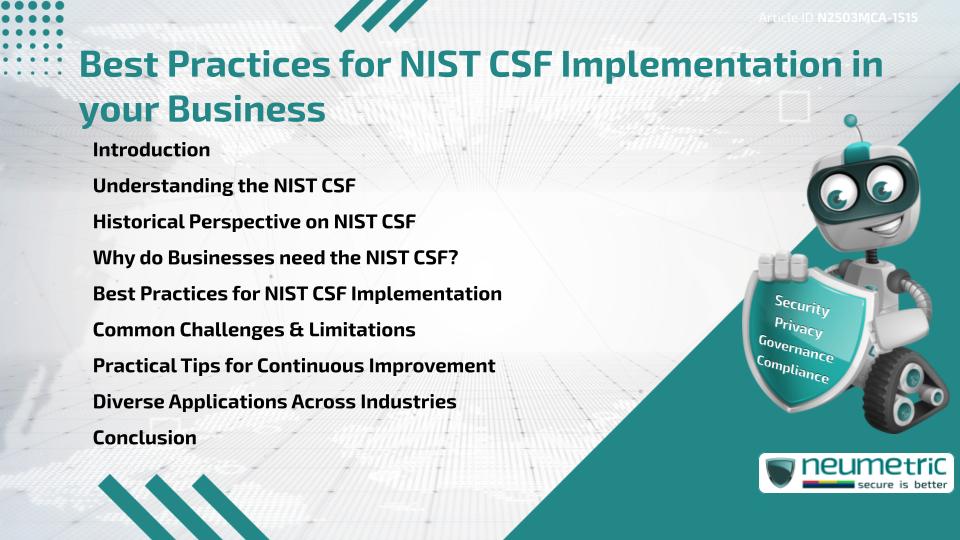Table of Contents
ToggleIntroduction
In today’s digital world, Cybersecurity Risks are higher than ever. Businesses, no matter their size or sector, need a structured way to manage these risks. This is where the National Institute of Standards & Technology Cybersecurity Framework [NIST CSF] comes into play. It offers a flexible set of guidelines to help Organisations build stronger defenses. In this article, we will explore the Best Practices for NIST CSF implementation, offering practical advice to make your journey smooth & effective.
Understanding the NIST CSF
The NIST CSF was first introduced in 2014 to help Critical Infrastructure Organisations manage Cybersecurity Risks. Over time, it has evolved into a go-to Framework for all Industries. The Best Practices for NIST CSF focus on five Core Functions: Identify, Protect, Detect, Respond & Recover.
Each function serves as a pillar, creating a full-circle approach to managing Threats & Vulnerabilities.
Historical Perspective on NIST CSF
The NIST CSF was born out of necessity after a series of major Cyberattacks on Critical Infrastructure in the United States. NIST, known for setting Industry Standards, answered this call with a Framework that was both rigorous & flexible.
One of the Best Practices for NIST CSF is understanding its roots. Knowing that it was designed for resilience during National Emergencies reminds Businesses that Cybersecurity is not just a Technical issue, but a core part of Survival & Success.
Why do Businesses need the NIST CSF?
Many Businesses wonder why they should invest time in Frameworks like the NIST CSF. The answer is simple: without a guide, managing Cybersecurity can feel difficult.
Best practices for NIST CSF help Businesses prioritise Risks, allocate Resources wisely & create Repeatable Processes. Instead of reacting to threats, Companies build proactive defenses. Whether you run a Healthcare Clinic, a Fintech Startup or a Global Retailer, the NIST CSF provides a Roadmap for Safer Operations.
Best Practices for NIST CSF Implementation
Implementing the Best Practices for NIST CSF does not need to be overwhelming. Here are simple steps to guide you:
- Start Small & Build: Focus first on high-risk areas. You do not need to cover everything at once.
- Customise the Framework: Adapt the Guidelines to your Industry, Size & Needs. The NIST CSF is not a one-size-fits-all solution.
- Engage Leadership early: Without top-level support, Cybersecurity efforts can lose momentum.
- Conduct regular Risk Assessments: A clear view of Threats allows you to prioritise effectively.
- Document Processes: Keep a record of how Cybersecurity tasks are handled, reviewed & improved.
- Train Your Staff: People are often the weakest link. Regular Training is part of the Best Practices for NIST CSF.
- Use Metrics: Track your progress through Measurable Outcomes.
Common Challenges & Limitations
While the NIST CSF offers many advantages, it is important to recognise its limitations.
One of the main challenges is that it is voluntary. This means unless there is strong internal motivation, Organisations may not implement it fully.
Another challenge is the potential cost of setting up comprehensive Security Programs. Smaller Businesses might find it difficult to assign enough Budget or Staff.
Best practices for NIST CSF encourage a Phased Approach to overcome these hurdles.
Practical Tips for Continuous Improvement
Cybersecurity is not a one-time project. It is a living process that must evolve as threats change.
Here are some tips based on the Best Practices for NIST CSF:
- Review Framework Alignment Annually: Check if your activities still match the Framework’s Expectations.
- Learn from Incidents: Every Security Event is a learning opportunity.
- Stay Informed: Keep up with changes to the NIST CSF & new Cybersecurity Trends.
- Benchmark Against Others: Compare your progress with similar Organisations.
Following these tips ensures that your security efforts stay strong & flexible over time.
Diverse Applications Across Industries
One of the greatest strengths of the NIST CSF is its adaptability.
- In Healthcare, it protects Patient Data under Regulations like HIPAA.
- In Finance, it helps Safeguard Transactions & Sensitive Client Information.
- In Manufacturing, it ensures the security of Supply Chains & Industrial Systems.
No matter the Industry, Best Practices for NIST CSF apply. Its flexibility allows Businesses to pick & apply what fits best.
Conclusion
A powerful, proven guide for managing Cybersecurity Risks is provided by NIST CSF. By following Best Practices for NIST CSF, Businesses can create strong, adaptable defenses without becoming overwhelmed. Remember, implementation is a journey. Taking steady, thoughtful steps ensures long-term success.
Takeaways
- Best Practices for NIST CSF include starting small, involving Leadership & continuous Training.
- Understanding historical roots adds depth to your Cybersecurity Strategy.
- Challenges exist but can be overcome with phased implementation.
- NIST CSF Framework can be used successfully by Industries across the board.
FAQ
What is the first step in implementing the Best Practices for NIST CSF?
The first step is identifying your highest Cybersecurity Risks & mapping them to the Core Functions of the NIST CSF.
How often should Businesses review their NIST CSF activities?
As a part of Best Practices for NIST CSF, it is recommended to review activities at least once every year or after any major Cybersecurity Incident.
Can Small Businesses afford to follow Best Practices for NIST CSF?
Yes, by starting small, focusing on the most critical Risks & customising the Framework, even Small Businesses can benefit from Best Practices for NIST CSF.
How does Employee Training fit into the Best Practices for NIST CSF?
Employee Training is crucial. Best practices for NIST CSF stress that informed & alert Employees are a strong first line of defense against Cyber Threats.
Is every part of the NIST CSF necessary to implemented?
No, the Best Practices for NIST CSF recommend customising the Framework to your Business Needs rather than attempting to implement every part.
Does using the NIST CSF guarantee no Cybersecurity Incidents?
No Framework can offer complete protection. Best practices for NIST CSF help reduce Risks & improve Response but do not eliminate all Threats.
How do I measure success in implementing Best Practices for NIST CSF?
Use measurable outcomes such as reduced Incidents, faster Response Time & Compliance Scores to track success.
Can NIST CSF be used with other Cybersecurity Standards?
Yes, Best Practices for NIST CSF allow it to integrate smoothly with Standards like ISO 27001 or HIPAA requirements.
Need help?
Neumetric provides organisations the necessary help to achieve their Cybersecurity, Compliance, Governance, Privacy, Certifications & Pentesting goals.
Organisations & Businesses, specifically those which provide SaaS & AI Solutions, usually need a Cybersecurity Partner for meeting & maintaining the ongoing Security & Privacy needs & requirements of their Clients & Customers.
SOC 2, ISO 27001, NIST, HIPAA, HECVAT, EU GDPR are some of the Frameworks that are served by Fusion – a centralised, automated, AI-enabled SaaS Solution provided by Neumetric.
Reach out to us!


